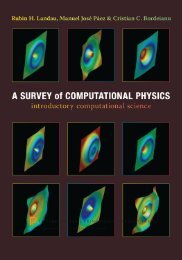Statistical Physics
Statistical Physics
Statistical Physics
- No tags were found...
You also want an ePaper? Increase the reach of your titles
YUMPU automatically turns print PDFs into web optimized ePapers that Google loves.
58 4 Ideal GasesWe can also verify that the pressure obtained from the free energy is thesame as before:( ) ∂FP = −= Nk B T 1 ∂VT,NV . (4.29)From the internal energy, we can calculate the heat capacity at constant volume:( ) ∂UC V == 3 ∂TV,N2 Nk B . (4.30)Since the internal energy U depends only on the temperature, and (∂V/∂T) P= V/T, (1.5) tells us that the constant-pressure heat capacity C P is given byC P = C V + Nk B . (4.31)This relation is known as the Mayer relation. (see Exercise 4 in Chap. 1.)The ratio C P /C V ≡ γ is known as the specific-heat ratio. In the presentcase γ =1.67. This value coincides with the experimental value for heliumgas, but for air at room temperature, γ is equal to 1.403. This discrepancyarises from the fact that air consists of diatomic molecules, as explained inthe next section.4.7 Diatomic Molecules4.7.1 Decomposition of the Partition FunctionThe monatomic molecules that we have considered in the previous sectionshave three degrees of freedom, associated with the motion of the center ofgravity. On the other hand, a diatomic molecule has six degrees of freedom,since it consists of two atoms. Therefore, in addition to the three degrees offreedom associated with the center of gravity, it has three degrees of freedomassociated with its internal motion. To describe the internal motion, we takea coordinate system attached to the molecule as shown in Fig. 4.7. The threedegrees of freedom of the internal motion can then be divided into two kinds:• Vibration in the x-direction. This has one degree of freedom.• Rotation around the y- andz-axes. This has two degrees of freedom.To be exact, there are also degrees of freedom associated with the motion ofthe electrons and with the rotation and vibration of the nucleus, but thesedegrees of freedom need not be considered at room temperature, for a reasonthat will be explained later. So here we consider the statistical mechanics ofdiatomic molecules taking account of the above six degrees of freedom.Now, because of these internal motions, the calculation of the partitionfunction of a diatomic-molecule gas becomes a little complicated. To reducethe complexity, we shall first show that the total partition function can be











![Práctica [PDF] - Universidad de Carabobo, FACYT - computacion](https://img.yumpu.com/48491415/1/190x245/practica-pdf-universidad-de-carabobo-facyt-computacion.jpg?quality=85)




